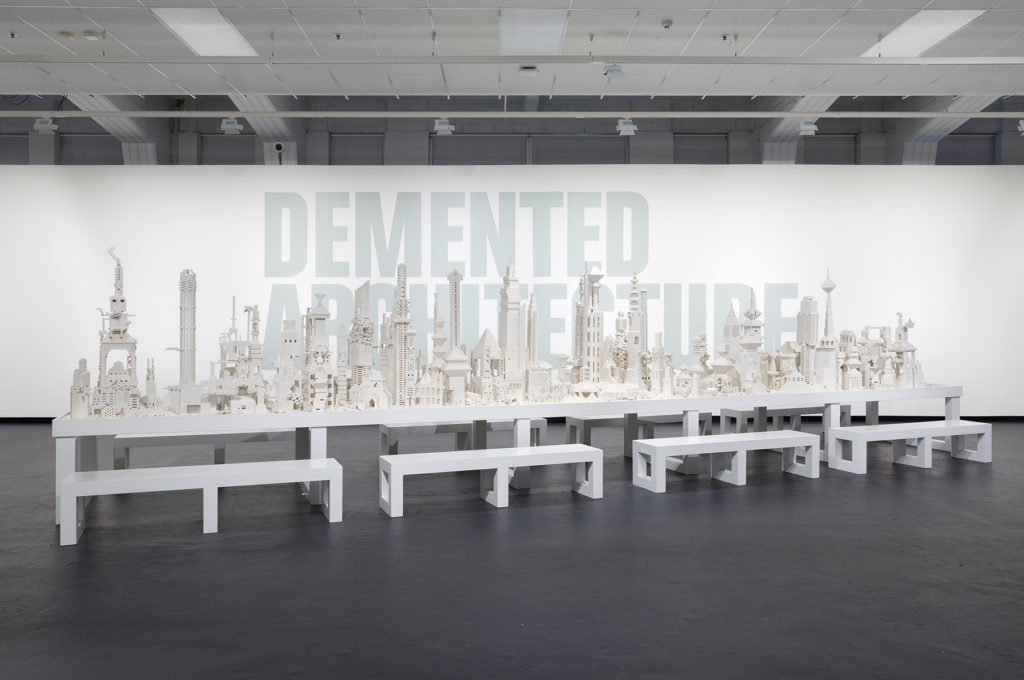ARTISTS Edgar Roy Brewster, Brodsky and Utkin, Jasmina Cibic, Henry Coombes, Olafur Eliasson, Zbigniew Libera, Kirsty Lillico, Claes Oldenburg CURATOR Aaron Lister PUBLICATION essay Aaron Lister
Demented Architecture takes architecture and the mythology of the architect as its subject. Olafur Eliasson’s participatory installation The Cubic Structural Evolution Project (2004) beckons visitors to sit at a long table covered with thousands of pieces of white Lego and play at ‘being architects’. The result is unbridled chaos. Visitors inevitably battle to build the largest, most phallic, most monolithic structure possible, destroying the creations and dreams of everyone else in the process. Just like in the real world. The close proximity to Polish artist Zbigniew Libera’s notorious Lego Concentration Camp (1996), loaned from the Modern Museum of Art in Warsaw, reminds us that even the most evil of architectural structures are made by humans for humans. Both works emphasise how architecture symbolises and carries the best and the worst of human intentions.
Megalomaniac architects can be found throughout the entire exhibition. Jasmina Cibic’s videos restage historical debates around art, architecture and power from post-war Yugoslavia. State architect Vinko Glanz regularly features, aggressively arguing that art and artists must submit to architectural form. The opposite scenario plays out in Scottish artist Henry Coombes’s I Am the Architect, This Is not Happening, This Is Unacceptable (2012). The video is set inside the attic and the confused mind of retired architect Clive who slowly surrenders the order and rationality of his profession to the impulsive and chaotic values of art.
This is also the territory of American pop artist Claes Oldenburg. The exhibition includes one of his unrealised and unrealisable proposals for a ‘colossal monument’—a Civic Cathedral in Seattle in the shape of a tap fed by a hand crank that extracts and shoots water back into Lake Union.
Demented Architecture includes documentation of an exhibition Palazzo Nero by Russian paper-architects Alexander Brodsky and Ilya Utkin at City Gallery in 1992. It featured two wooden architectural structures—one located inside the gallery, the other outside in Civic Square. The latter work, Monument, collapsed after just two days of exposure to Wellington’s notorious weather. Wellington artist Kirsty Lillico’s soft-sculptures sit somewhere between paper architecture and real architecture. For one of these works, she traced, cut and folded the floor plan of her modernist apartment into a piece of carpet salvaged from a skip bin. A second subjects Le Corbusier’s Unité d'Habitation (1952) to the same brutalist treatment, rendering his modernist vision flaccid and dirty. A third turns to fictional architecture, remaking Dr. Robert Laing’s apartment from J.G. Ballard’s novel High Rise in City Gallery’s own dumped back-of-house carpet.
This line between an architecture of the imagination and real-world architectural solutions is most dementedly embodied in The Norian House, built by beekeeper Edgar Roy Brewster in New Plymouth in the early 1950s. Drawings, plans, and actual window fittings from this house are included in the show. Inspired by the beehive as a model for harmonious existence, all of the house’s features, fittings and furniture took hexagonal form. The right angle was banned from Brewster’s Norian ‘No Right Angles philosophy’ as evil. The swastika, he noted, is made up of twenty right angles. Brewster’s model for an unrealised hexagonal skyscraper sits in Demented Architecture on a square plinth. The gallery, and the world it sits in, is not ready to become hexagonal—not yet.























































